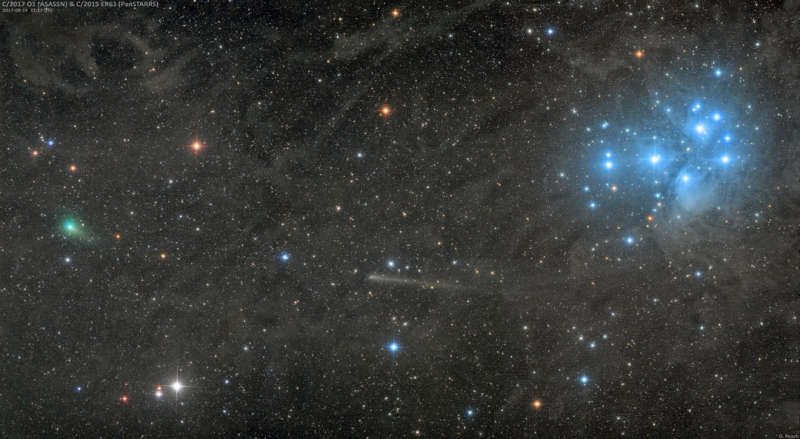Credit & Copyright: Damian Peach
Explanation:
Two unusual spots are on the move near the famous Pleiades star cluster.
Shifting only a small amount per night,
these spots are actually
comets
in our nearby Solar System that by chance wandered
into the field of the
light-years distant stars.
On the far left is comet
C/2017 O1 ASAS-SN, a multi-kilometer
block of evaporating ice sporting a
bright coma of surrounding gas dominated by
green-glowing carbon.
Comet ASAS-SN1
shows a slight tail to its lower right.
Near the frame center is comet
C/2015 ER61 PanSTARRS,
also a giant block of
evaporating ice,
but sporting a rather
long tail to its right.
On the upper right is
the Pleiades, an
open cluster
dominated by bright blue stars illuminating
nearby reflecting dust.
This exposure, taken about two weeks ago,
is so deep that the filamentary interstellar dust can be traced across the
entire field.
The Pleiades is visible to the
unaided
eye, but it should require binoculars to
see the comets.
1999 2000 2001 2002 2003 2004 2005 2006 2007 2008 2009 2010 2011 2012 2013 2014 2015 2016 2017 2018 2019 2020 2021 2022 2023 2024 2025 |
Январь Февраль Март Апрель Май Июнь Июль Август Сентябрь Октябрь Ноябрь Декабрь |
NASA Web Site Statements, Warnings, and Disclaimers
NASA Official: Jay Norris. Specific rights apply.
A service of: LHEA at NASA / GSFC
& Michigan Tech. U.
|
Публикации с ключевыми словами:
comet - pleiades - кометы - Плеяды
Публикации со словами: comet - pleiades - кометы - Плеяды | |
См. также:
Все публикации на ту же тему >> | |
